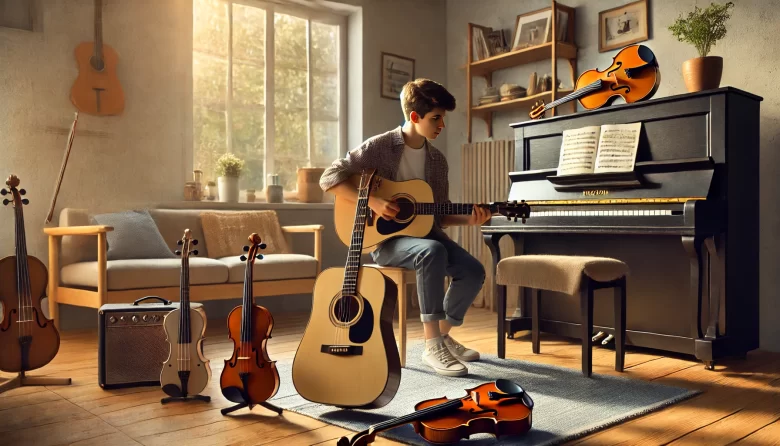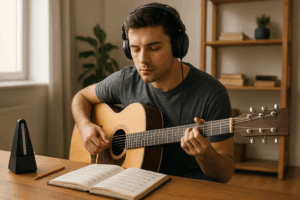Starting your journey into the world of music is an exciting adventure, full of discovery, creativity, and self-expression. One of the most crucial decisions in this process is selecting the right musical instrument to learn. The instrument you choose can significantly influence your motivation, learning experience, and overall enjoyment of the process.
Whether you’re fascinated by the soulful strum of a guitar, the expressive keys of a piano, or the pulse of a drumbeat, the right choice can make all the difference. This guide will walk you through all the essential factors to consider when choosing a beginner-friendly musical instrument that matches your interests, budget, space, and long-term goals.
1. Discover Your Musical Identity
The first and perhaps most important step in choosing your instrument is to explore your personal musical tastes. Ask yourself: What kind of music do I enjoy listening to the most? Do I imagine myself performing rock, classical, pop, jazz, or folk?
Your musical preferences can serve as a compass that guides you to the right instrument. Here are a few popular choices aligned with various genres:
- Guitar: A flexible and widely popular choice, the guitar fits seamlessly into genres like rock, pop, country, blues, and even classical. It’s also portable and easy to find learning resources for.
- Piano: Ideal for classical music enthusiasts and those who want a strong foundation in music theory. The piano is also used in jazz, pop, and film scores.
- Drums: If rhythm is your passion and you love energetic, percussive beats, drums are your go-to instrument. Great for rock, jazz, funk, and many other upbeat genres.
- Violin: Best known for its role in classical music but also used in folk, bluegrass, and country.
- Ukulele: A cheerful, compact, and easy-to-learn instrument, great for beginners and casual players who enjoy light, melodic sounds.
2. Match Your Budget with Your Goals
Another critical aspect to consider is your budget. Instruments vary widely in price, and it’s important to set a realistic spending range based on your current financial situation and commitment level.
Affordable Options for Beginners:
- Ukulele: Compact and very budget-friendly. Excellent for quick learning and fun practice.
- Keyboard: A cost-effective alternative to a piano with many features for beginners.
- Acoustic Guitar: Widely available at entry-level prices with good sound quality.
Instruments with Higher Initial Investment:
- Piano: Especially upright or grand pianos, which can be expensive and require space.
- Violin: While student models are available, high-quality violins can get pricey.
- Electric Guitar & Amplifier: A popular option but requires more accessories and cost.
Keep in mind: You don’t need a professional-grade instrument to start. Many reputable brands offer beginner versions that balance quality and affordability. Renting an instrument is also an option if you’re not yet ready to buy.
3. Consider Space and Living Conditions
Some instruments demand more room than others. If you’re living in a small apartment or shared space, choosing a compact instrument will make practicing easier and more convenient.
Great for Small Spaces:
- Ukulele
- Violin
- Keyboard
- Electric Guitar (with headphones!)
Instruments That Need More Room:
- Piano (especially upright or grand models)
- Drum Set
- Acoustic Guitar (though still manageable)
Before purchasing, visualize where your instrument will be stored and where you’ll practice. Noise considerations are also important—your neighbors might not appreciate a full drum solo at midnight!
4. Evaluate the Learning Curve
While every instrument has its challenges, some are known for being more accessible to beginners. It’s worth thinking about how quickly you want to see progress and how patient you’re willing to be as you develop your skills.
Easier Instruments to Learn:
- Ukulele: Fewer strings and simple chord shapes make it ideal for quick wins.
- Keyboard: Visual layout helps with understanding music theory and note relationships.
- Acoustic Guitar: Widely taught, with countless beginner tutorials and easy songs available.
Instruments That May Be More Challenging:
- Violin: Demands good ear training and posture. Producing a clean sound can take time.
- Saxophone or Clarinet: Woodwinds require strong breath control and precise finger placement.
- Drums: Rhythm coordination between hands and feet takes practice, though incredibly rewarding.
Choosing an easier instrument doesn’t mean you’re avoiding a challenge—it means you’re setting yourself up for early success and building confidence.
5. Try Before You Buy (If Possible)
If you can, go to a local music store or community center and try out a few instruments. Many stores offer demo instruments or even short trial lessons to help you get a feel for different choices.
Trying an instrument before committing helps you:
- Understand how it feels in your hands.
- Hear the tone up close.
- Discover which instrument excites you the most.
Some schools and local programs may even let you borrow instruments, so don’t hesitate to ask around.
6. Think About Your Commitment Level
Learning an instrument takes time and consistency. Before making a big purchase, ask yourself how committed you are to practicing regularly. If you’re exploring music as a hobby or trying it out, a lower-cost instrument like a ukulele or keyboard is perfect.
But if you’re already serious about music and see it as a long-term pursuit, consider investing in a higher-quality instrument that will grow with you as your skills improve.
Tip: Set small, achievable goals like learning one song or practicing 15 minutes a day. This keeps you motivated and helps build momentum.
7. Access to Learning Resources
One factor many beginners overlook is the availability of learning materials. Some instruments, like guitar and piano, have hundreds of free lessons, courses, and tutorials online—making it much easier to start learning on your own.
Others, like wind instruments or orchestral strings, might require formal instruction early on.
When choosing your instrument, ask:
- Are there online lessons available?
- Do apps support this instrument?
- Is there a local teacher or music school nearby?
Access to good resources can make or break your learning experience.
8. Think About Portability
Will you want to take your instrument to lessons, practice sessions with friends, or even on trips? Some instruments are far more portable than others.
- Highly Portable: Ukulele, violin, flute, harmonica.
- Moderately Portable: Acoustic guitar, keyboard (depending on size).
- Less Portable: Drum set, piano, electric instruments with accessories.
If you’re on the move often, portability might be a major deciding factor.
Final Thoughts: Make It Personal and Enjoy the Journey
Choosing your first musical instrument is not just about price or size—it’s about finding what inspires you. Think about your passions, your space, and your dedication. There is no single “best” instrument for everyone—only the best one for you.
Take your time, do some research, and trust your instincts. Most importantly, remember that learning music should be a joyful, enriching experience. Start with the instrument that excites you the most and let the rest fall into place with practice and patience.
Your musical journey begins with that very first note—make it count!




